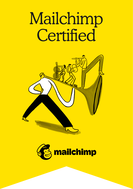Email Automation

On the web, there are two ways of communicating: Pull and Push. Websites are "Pull". We make them as useful and attractive as we can, then passively wait for someone to Google them or to tell someone else about them. We use Search Engine Optimization (SEO) to try to get to the top of the Google search, but there's a lot of competition for that spot, and SEO is a specialty all in itself. I can cover the basics, but without spending a lot of money it's hard to compete in this arena.
"Push" is where we actively push out our message and invite people to visit our website and perhaps subscribe for more. This way we connect with our audience and provide opportunities for more connection in the future. We can do this in a variety of ways, called "channels". Emails to subscribers, posts on our own social media, forums and affinity group pages, etc.. Any form of advertising is "push", including on-line using Facebook or Google and even mailing out postcards.
MailChimp is "the most popular email marketing platform on the market". It does a great job sending out automated emails, but it is much more than that! The MailChimp platform offers integrated solutions for all of the channels I mentioned above. I started using MailChimp for my client's blog, and it certainly does a great job for that. Then I started using their statistics and reporting to answer some questions about the blog subscribers and was very impressed with those. Along the way I kept seeing all these other features and realized, wow, this is an amazing marketing platform. So I decided to study it and earn MailChimp certification . But Mailchimp can be a bit of overkill for some clients, so I am also work with Ahrefs.
Now, many of my clients are not actually selling things. They are writing books, creating art, providing services, etc. But no matter what you do, once you have a website you want people to visit it, right? Websites are our information hub, but there is more to getting our message out than just publishing a website.
I got my MBA almost forty years ago, before the web was even invented. Back then I learned "People don't want quarter-inch drills, they want quarter-inch holes". In other words, what is really important is not the tool, but the outcome. That hasn't changed. The main -- and probably the only -- reason to have a website is to communicate with other people. Today's technology offers many ways to do that, but the website remains at the core. I am very excited to be able to offer email automation to help you expand your audience, connect in new ways and boost your communication to a new level.
"Push" is where we actively push out our message and invite people to visit our website and perhaps subscribe for more. This way we connect with our audience and provide opportunities for more connection in the future. We can do this in a variety of ways, called "channels". Emails to subscribers, posts on our own social media, forums and affinity group pages, etc.. Any form of advertising is "push", including on-line using Facebook or Google and even mailing out postcards.
MailChimp is "the most popular email marketing platform on the market". It does a great job sending out automated emails, but it is much more than that! The MailChimp platform offers integrated solutions for all of the channels I mentioned above. I started using MailChimp for my client's blog, and it certainly does a great job for that. Then I started using their statistics and reporting to answer some questions about the blog subscribers and was very impressed with those. Along the way I kept seeing all these other features and realized, wow, this is an amazing marketing platform. So I decided to study it and earn MailChimp certification . But Mailchimp can be a bit of overkill for some clients, so I am also work with Ahrefs.
Now, many of my clients are not actually selling things. They are writing books, creating art, providing services, etc. But no matter what you do, once you have a website you want people to visit it, right? Websites are our information hub, but there is more to getting our message out than just publishing a website.
I got my MBA almost forty years ago, before the web was even invented. Back then I learned "People don't want quarter-inch drills, they want quarter-inch holes". In other words, what is really important is not the tool, but the outcome. That hasn't changed. The main -- and probably the only -- reason to have a website is to communicate with other people. Today's technology offers many ways to do that, but the website remains at the core. I am very excited to be able to offer email automation to help you expand your audience, connect in new ways and boost your communication to a new level.

